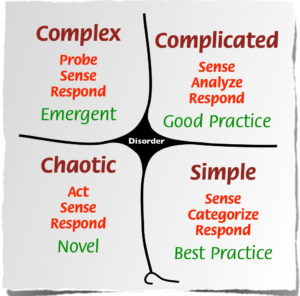Have you ever found yourself stuck between opposing forces? Perhaps you’re trying to implement a new policy at work, but facing resistance from colleagues comfortable with the status quo. Or maybe you’re attempting to kick a bad habit like smoking, but the addictive cravings keep pulling you back. In situations like these, force field analysis can be an invaluable tool for understanding and overcoming the driving and restraining forces at play.
Force field analysis is a decision-making technique that helps visualize and analyze the forces for and against a proposed change. By mapping out these opposing forces, you can devise strategies to strengthen the driving forces and mitigate the restraining forces, increasing your chances of successful change implementation.
In this comprehensive guide, we’ll explore the ins and outs of force field analysis, covering its definition, history, applications, step-by-step process, examples, and more.
Get ready to unlock a powerful problem-solving technique that can help you navigate through life’s toughest challenges.
What is Force Field Analysis?
Force field analysis is a decision-making and problem-solving technique that helps analyze the forces for and against a proposed change. It involves creating a visual representation, typically a diagram, that depicts the driving forces (those that support the change) and the restraining forces (those that oppose the change).
The core idea behind force field analysis is that any situation, plan, or decision is a result of opposing forces. By identifying and understanding these forces, you can develop strategies to strengthen the driving forces and weaken the restraining forces, ultimately tipping the balance in favor of the desired change.
A Brief History of Force Field Analysis
Force field analysis was developed by Kurt Lewin, a German-American psychologist and influential figure in the field of social psychology. Lewin introduced the concept in the 1940s as part of his work on organizational change and group dynamics.
Lewin’s force field theory proposed that behavior is the result of a balance between driving forces (those that push for change) and restraining forces (those that resist change). By analyzing these forces, individuals and organizations can better understand the dynamics at play and develop strategies to facilitate or resist change.
Since its introduction, force field analysis has been widely adopted across various fields, including business, education, social work, and personal development, as a valuable tool for decision-making and problem-solving.
Applications of Force Field Analysis
Force field analysis can be applied in a wide range of situations where change is involved. Here are some common applications:
- Organizational Change Management: When implementing new policies, procedures, or restructuring initiatives within an organization, force field analysis can help identify potential barriers and driving forces, allowing for more effective change strategies.
- Personal Development: Force field analysis can be used to analyze the forces influencing personal goals or habits, such as losing weight, quitting smoking, or improving time management skills.
- Strategic Planning: In strategic planning processes, force field analysis can assist in evaluating the feasibility and potential challenges of proposed strategies or initiatives.
- Conflict Resolution: By mapping out the driving and restraining forces behind a conflict, force field analysis can provide insights into finding resolutions or compromises.
- Project Management: During project planning and execution, force field analysis can help identify potential risks, obstacles, and opportunities, enabling proactive risk management strategies.
- Marketing and Sales: Force field analysis can be used to analyze the driving and restraining forces affecting consumer behavior, product adoption, or sales strategies.
- Social Change and Advocacy: In efforts to promote social change or address societal issues, force field analysis can shed light on the forces supporting or hindering progress, informing more effective advocacy strategies.
How to Conduct a Force Field Analysis
Conducting a force field analysis involves the following steps:
- Define the Change or Decision: Clearly state the proposed change, goal, or decision you want to analyze.
- Identify the Driving Forces: List all the factors that support or facilitate the change. These can include resources, motivations, opportunities, or positive consequences.
- Identify the Restraining Forces: List all the factors that oppose or hinder the change. These can include obstacles, risks, costs, fears, or negative consequences.
- Assign Weights or Scores: Optionally, you can assign weights or scores to each force to indicate their relative importance or impact.
- Visualize the Forces: Create a diagram or visual representation of the driving and restraining forces, with arrows or vectors depicting their relative strengths or weights.
- Analyze the Balance: Evaluate the overall balance between the driving and restraining forces. If the driving forces are stronger, the change is more likely to be successful. If the restraining forces are stronger, the change may face significant challenges.
- Develop Strategies: Based on the analysis, devise strategies to strengthen the driving forces, weaken the restraining forces, or introduce new forces to tip the balance in favor of the desired change.
- Implement and Monitor: Put the strategies into action and monitor their effectiveness. Be prepared to adjust the strategies as needed based on changing circumstances or new information.
Force Field Analysis Examples
To better understand force field analysis, let’s consider a few examples:
Example 1: Implementing a New Recycling Program
Proposed Change: Introducing a comprehensive recycling program in a community.
Driving Forces: Environmental awareness, cost savings from reduced waste disposal, potential revenue from recycled materials, community pride, and legal requirements.
Restraining Forces: Initial setup costs, lack of convenient recycling facilities, resistance to change from residents, and potential opposition from waste management companies.
Strategies: Educate residents on the benefits of recycling, secure funding for recycling infrastructure, implement incentives or fines to encourage participation, and collaborate with waste management companies to address their concerns.
Example 2: Quitting Smoking
Proposed Change: Quitting smoking.
Driving Forces: Improved health, financial savings, setting a good example for family, and avoiding social stigma.
Restraining Forces: Nicotine addiction, stress relief associated with smoking, social pressure from smoking peers, and fear of weight gain.
Strategies: Seek support from a smoking cessation program, use nicotine replacement therapy, adopt healthy stress management techniques, avoid triggers or high-risk situations, and engage in physical activities to manage weight concerns.
Example 3: Launching a New Product
Proposed Change: Introducing a new product line to the market.
Driving Forces: Potential market demand, competitive advantage, diversification of product portfolio, and opportunities for revenue growth.
Restraining Forces: Development costs, manufacturing challenges, marketing and distribution expenses, and potential market saturation or competition.
Strategies: Conduct thorough market research, secure adequate funding, streamline production processes, implement effective marketing campaigns, and develop unique selling propositions to differentiate the product.
Advantages and Disadvantages of Force Field Analysis
Like any decision-making tool, force field analysis has its strengths and weaknesses. Here are some key advantages and disadvantages to consider:
Advantages
- Visual Representation: The visual nature of force field analysis makes it easy to understand and communicate the driving and restraining forces at play.
- Structured Approach: The structured process of identifying and analyzing forces helps ensure a comprehensive and systematic evaluation.
- Objectivity: Force field analysis encourages an objective assessment of both supporting and opposing forces, reducing the risk of bias.
- Collaborative Decision-Making: The technique can be used in group settings, fostering collaboration and buy-in from stakeholders.
- Adaptability: Force field analysis can be applied to a wide range of situations and contexts, making it a versatile problem-solving tool.
Disadvantages
- Subjectivity in Assigning Weights: The process of assigning weights or scores to forces can be subjective and prone to individual biases.
- Static Nature: Force field analysis provides a snapshot of forces at a specific point in time but may not account for dynamic changes or emerging forces.
- Oversimplification: In complex situations, reducing forces to a binary classification (driving or restraining) may oversimplify the dynamics at play.
- Limited Quantitative Analysis: While force field analysis is useful for qualitative analysis, it may not provide robust quantitative data or precise measurements.
- Implementation Challenges: Developing and executing effective strategies based on the analysis can be challenging, requiring additional planning and resources.
Force Field Analysis Tools and Templates
To facilitate the process of conducting force field analysis, various tools and templates are available. Here are some popular options:
- Diagrams and Whiteboards: Simple diagrams or illustrations on whiteboards or paper can be used to visually map out the driving and restraining forces.
- Spreadsheets: Spreadsheet software like Microsoft Excel or Google Sheets can be used to create force field analysis templates, allowing for easy organization and calculation of weighted forces.
- Mind Mapping Tools: Mind mapping software like MindNode or XMind can be utilized to create visual representations of the forces, with the ability to add notes, links, and other supporting information.
- Online Tools and Templates: Various online platforms offer pre-built force field analysis templates and tools, such as Lucidchart, Miro, or Canva.
- Project Management Software: Some project management tools like Trello or Asana incorporate force field analysis templates or features to help teams analyze and manage project risks and challenges.
These tools and templates can streamline the process, enhance collaboration, and provide a more structured approach to conducting force field analysis.
Force Field Analysis Template
+++++++++++++++++++++++++
+ PROPOSED CHANGE +
+++++++++++++++++++++++++
---------------------------
| DRIVING FORCES |
---------------------------
| + Force 1 |
| + Force 2 |
| + Force 3 |
| |
| |
---------------------------
---------------------------
| RESTRAINING FORCES |
---------------------------
| - Force 1 |
| - Force 2 |
| |
| |
| |
---------------------------
STRATEGIES:
1. Strategy to strengthen driving forces:
-
2. Strategy to weaken restraining forces:
-
3. Additional strategies:
-To use this template:
- Replace “PROPOSED CHANGE” with your specific change, goal, or decision you want to analyze.
- Under “DRIVING FORCES”, list out all the factors that support or facilitate the change. Use “+” before each force.
- Under “RESTRAINING FORCES”, list all the factors that oppose or hinder the change. Use “-” before each force.
- Optionally, you can assign weights or scores to each force by adding numbers next to them.
- In the “STRATEGIES” section, outline your proposed strategies to strengthen the driving forces, weaken the restraining forces, or introduce new forces to tip the balance.
You can easily copy and paste this template into a text editor or spreadsheet program for your force field analysis.
TL;DR
Force field analysis is a decision-making and problem-solving technique that helps analyze the driving and restraining forces influencing a proposed change or decision. By identifying and understanding these opposing forces, individuals and organizations can develop strategies to strengthen the driving forces and mitigate the restraining forces, increasing the chances of successful change implementation.
The process involves defining the change, identifying the driving and restraining forces, visualizing them in a diagram, assigning weights or scores if desired, analyzing the overall balance, and devising strategies based on the analysis. Force field analysis can be applied in various contexts, such as organizational change management, personal development, strategic planning, conflict resolution, project management, marketing, and social change initiatives.
While force field analysis offers advantages like visual representation, structured approach, objectivity, and adaptability, it also has potential limitations, including subjectivity in assigning weights, static nature, oversimplification of complex dynamics, limited quantitative analysis, and challenges in implementing strategies.
By leveraging tools and templates like diagrams, spreadsheets, mind mapping software, online platforms, and project management tools, force field analysis can be conducted more efficiently and collaboratively.
Q&A
Q: How does force field analysis differ from other decision-making techniques like SWOT analysis or cost-benefit analysis?
A: Force field analysis is distinct in its focus on identifying and analyzing the opposing forces that influence a specific change or decision. SWOT analysis is a broader tool for evaluating strengths, weaknesses, opportunities, and threats, while cost-benefit analysis primarily focuses on the financial aspects of a decision. Force field analysis provides a more targeted approach to understanding the driving and restraining forces at play, allowing for the development of tailored strategies.
Q: Can force field analysis be used for personal decisions, or is it primarily meant for organizational or business contexts?
A: Force field analysis can be applied to personal decisions and goals, as well as organizational or business contexts. The technique is versatile and can be used to analyze the driving and restraining forces influencing any proposed change, whether it’s related to personal habits, career choices, relationships, or other aspects of life. The process remains the same, but the specific forces identified will be relevant to the individual’s personal circumstances.
Q: How can you ensure objectivity when identifying and weighing the forces in a force field analysis?
A: To maintain objectivity, it’s essential to involve multiple perspectives and stakeholders in the process. Encourage open discussions and challenge assumptions or biases. Additionally, consider using structured rating or scoring systems, rather than relying solely on subjective judgments. It can also be helpful to review and revise the identified forces after an initial assessment, as new insights may emerge over time.
Q: What should be done if there is a significant imbalance between the driving and restraining forces, with the restraining forces being much stronger?
A: If the restraining forces are significantly stronger than the driving forces, it may indicate that the proposed change or decision is not feasible or practical in its current form. In such cases, it’s important to reevaluate the situation and consider alternative approaches or modifications to the proposal. This could involve introducing new driving forces, finding ways to significantly weaken or eliminate critical restraining forces, or adjusting the scope or timeline of the change to make it more manageable.
Q: How can force field analysis be integrated with other decision-making or problem-solving techniques for a more comprehensive approach?
A: Force field analysis can be combined with other techniques to provide a more holistic and comprehensive approach to decision-making and problem-solving. For example, it can be used in conjunction with root cause analysis to identify underlying drivers of restraining forces, or with risk assessment methods to evaluate the potential impact of identified forces. It can also be incorporated into project management methodologies, strategic planning processes, or change management frameworks for a more robust and structured approach to change implementation.





